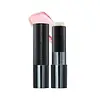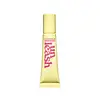What's inside
What's inside
 Key Ingredients
Key Ingredients

 Benefits
Benefits

 Concerns
Concerns

 Ingredients Side-by-side
Ingredients Side-by-side

Diisostearyl Malate
EmollientCaprylic/Capric Triglyceride
MaskingPolyglyceryl-2 Isostearate
EmulsifyingHydrogenated Polyisobutene
EmollientOctyldodecanol
EmollientButyrospermum Parkii Butter
Skin ConditioningMicrocrystalline Wax
Emulsion StabilisingPolyethylene
AbrasiveCeresin
Emulsion Stabilising1,2-Hexanediol
Skin ConditioningEthylhexylglycerin
Skin ConditioningPhenoxyethanol
PreservativeGlycerin
HumectantTocopheryl Acetate
AntioxidantRosa Canina Fruit Oil
EmollientPrunus Armeniaca Kernel Oil
MaskingPersea Gratissima Oil
Skin ConditioningMacadamia Ternifolia Seed Oil
EmollientButylene Glycol
HumectantWater
Skin ConditioningPropylene Glycol
HumectantHydrogenated Lecithin
EmulsifyingCeramide NP
Skin ConditioningAnemarrhena Asphodeloides Root Extract
Skin ConditioningCI 45410
Cosmetic ColorantParfum
MaskingDiisostearyl Malate, Caprylic/Capric Triglyceride, Polyglyceryl-2 Isostearate, Hydrogenated Polyisobutene, Octyldodecanol, Butyrospermum Parkii Butter, Microcrystalline Wax, Polyethylene, Ceresin, 1,2-Hexanediol, Ethylhexylglycerin, Phenoxyethanol, Glycerin, Tocopheryl Acetate, Rosa Canina Fruit Oil, Prunus Armeniaca Kernel Oil, Persea Gratissima Oil, Macadamia Ternifolia Seed Oil, Butylene Glycol, Water, Propylene Glycol, Hydrogenated Lecithin, Ceramide NP, Anemarrhena Asphodeloides Root Extract, CI 45410, Parfum
Hydrogenated Polyisobutene
EmollientDiisostearyl Malate
EmollientSilica Dimethyl Silylate
EmollientMicrocrystalline Wax
Emulsion StabilisingSorbitan Isostearate
EmulsifyingCaprylyl Glycol
EmollientCetyl PEG/PPG-10/1 Dimethicone
EmulsifyingEthylene/Propylene Copolymer
AbrasiveParfum
MaskingTocopheryl Acetate
AntioxidantButylene/Ethylene/Styrene Copolymer
Water
Skin ConditioningAscorbic Acid
AntioxidantPolyglyceryl-2 Triisostearate
EmulsifyingCetyl Ethylhexanoate
EmollientHydrogenated Castor Oil Dimer Dilinoleate
Skin Conditioning1,2-Hexanediol
Skin ConditioningCI 77891
Cosmetic ColorantCI 15985
Cosmetic ColorantCI 42090
Cosmetic ColorantCI 15850
Cosmetic ColorantCitrus Junos Fruit Extract
Skin ConditioningAcetyl Octapeptide-3
HumectantPalmitoyl Pentapeptide-4
Skin ConditioningPalmitoyl Tetrapeptide-7
Skin ConditioningTripeptide-1
Skin ConditioningTripeptide-2
Skin ConditioningHydrogenated Polyisobutene, Diisostearyl Malate, Silica Dimethyl Silylate, Microcrystalline Wax, Sorbitan Isostearate, Caprylyl Glycol, Cetyl PEG/PPG-10/1 Dimethicone, Ethylene/Propylene Copolymer, Parfum, Tocopheryl Acetate, Butylene/Ethylene/Styrene Copolymer, Water, Ascorbic Acid, Polyglyceryl-2 Triisostearate, Cetyl Ethylhexanoate, Hydrogenated Castor Oil Dimer Dilinoleate, 1,2-Hexanediol, CI 77891, CI 15985, CI 42090, CI 15850, Citrus Junos Fruit Extract, Acetyl Octapeptide-3, Palmitoyl Pentapeptide-4, Palmitoyl Tetrapeptide-7, Tripeptide-1, Tripeptide-2
Ingredients Explained
These ingredients are found in both products.
Ingredients higher up in an ingredient list are typically present in a larger amount.
1,2-Hexanediol is a synthetic liquid and another multi-functional powerhouse.
It is a:
- Humectant, drawing moisture into the skin
- Emollient, helping to soften skin
- Solvent, dispersing and stabilizing formulas
- Preservative booster, enhancing the antimicrobial activity of other preservatives
Diisostearyl Malate is an emollient and most often used in lip products. It comes from isostearyl alcohol, a fatty acid, and malic acid, an AHA.
As an emollient, Diisostearyl Malate helps create a thin film on your skin to trap moisture in. This helps keep your skin soft and smooth.
Hydrogenated Polyisobutene is a synthetic polymer. Polymers are compounds with high molecular weight. Hydrogenated Polyisobutene is an emollient and texture enhancer.
In one study, Hydrogenated Polyisobutene showed better skin hydration levels than Caprylic/Capric Triglyceride. As an emollient, it helps keep your skin soft and hydrated by trapping moisture in.
Hydrogenated Polyisobutene is often used as a mineral oil replacement.
Learn more about Hydrogenated PolyisobuteneMicrocrystalline Wax is created by de-oiling petroleum. It is highly refined and purified before being added to cosmetics.
Microcrystalline Wax is used to enhance the texture and create even consistency. It helps stabilize a product by preventing ingredients from separating.
Parfum is a catch-all term for an ingredient or more that is used to give a scent to products.
Also called "fragrance", this ingredient can be a blend of hundreds of chemicals or plant oils. This means every product with "fragrance" or "parfum" in the ingredients list is a different mixture.
For instance, Habanolide is a proprietary trade name for a specific aroma chemical. When used as a fragrance ingredient in cosmetics, most aroma chemicals fall under the broad labeling category of “FRAGRANCE” or “PARFUM” according to EU and US regulations.
The term 'parfum' or 'fragrance' is not regulated in many countries. In many cases, it is up to the brand to define this term.
For instance, many brands choose to label themselves as "fragrance-free" because they are not using synthetic fragrances. However, their products may still contain ingredients such as essential oils that are considered a fragrance by INCI standards.
One example is Calendula flower extract. Calendula is an essential oil that still imparts a scent or 'fragrance'.
Depending on the blend, the ingredients in the mixture can cause allergies and sensitivities on the skin. Some ingredients that are known EU allergens include linalool and citronellol.
Parfum can also be used to mask or cover an unpleasant scent.
The bottom line is: not all fragrances/parfum/ingredients are created equally. If you are worried about fragrances, we recommend taking a closer look at an ingredient. And of course, we always recommend speaking with a professional.
Learn more about ParfumTocopheryl Acetate is AKA Vitamin E. It is an antioxidant and protects your skin from free radicals. Free radicals damage the skin by breaking down collagen.
One study found using Tocopheryl Acetate with Vitamin C decreased the number of sunburned cells.
Tocopheryl Acetate is commonly found in both skincare and dietary supplements.
Learn more about Tocopheryl AcetateWater. It's the most common cosmetic ingredient of all. You'll usually see it at the top of ingredient lists, meaning that it makes up the largest part of the product.
So why is it so popular? Water most often acts as a solvent - this means that it helps dissolve other ingredients into the formulation.
You'll also recognize water as that liquid we all need to stay alive. If you see this, drink a glass of water. Stay hydrated!
Learn more about Water